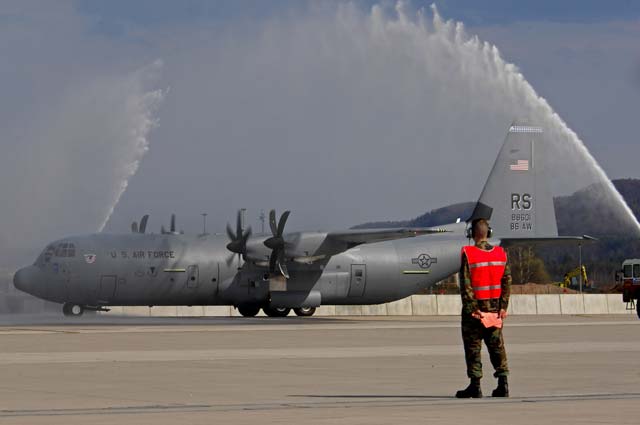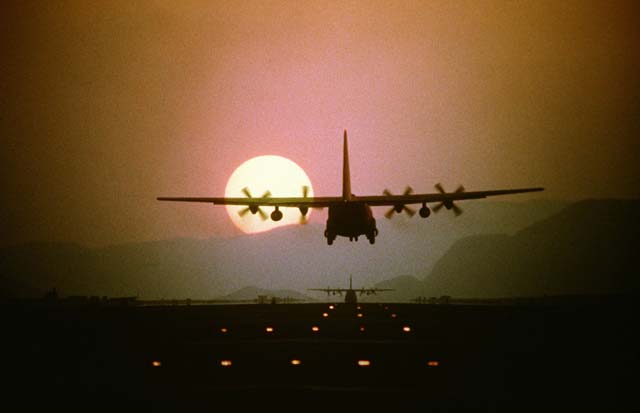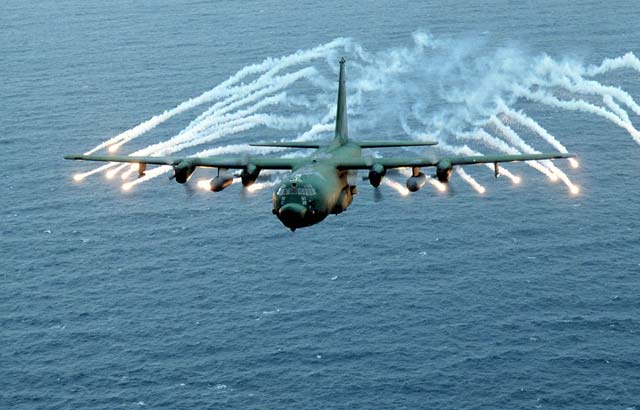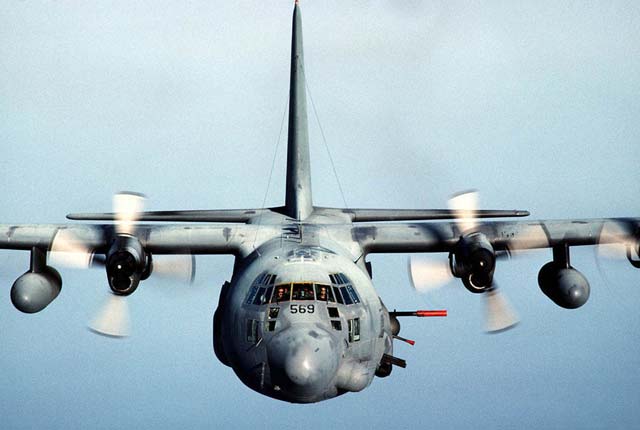
The first U.S. Air Force C-130J to be assigned to the Ramstein Air Base fleet taxies under pressured water from two Ramstein fire trucks during a celebration ceremony April 7, 2009. The J-model landed on Ramstein for the first time during a ceremony held to not only honor the arrival of the new aircraft but also a new era in operations for the 86th Airlift Wing.
It was Aug. 23, 1954, when the prototype YC-130 took off for its inaugural flight from Lockheed Air Terminal — now Bob Hope Airport — in Los Angeles County, California.
The aircraft’s history began in 1951 when the Air Force issued a request for proposal for a medium cargo plane. The Lockheed Aircraft Company was awarded the contract.
The Air Force needed an aircraft that could haul large, bulky equipment over long distances, land in tight spaces, slow to 125 knots to allow for paratroop drops and, if need be, fly with one engine. Lockheed’s response to that was the C-130, an aircraft much different than the jets that were more the focus of the time.

Introduced in August 1962, the C-130E Hercules used the same Allison T56-A-7 engine as the C-130B but had two additional 1,290-gallon external fuel tanks and an increased maximum takeoff weight capability. June 1974 saw the first C-130Hs with more powerful Allison T56-A-15 turboprop engines. Though nearly identical to the C-130E externally, the new engine brought major performance improvements. The latest C-130 to be produced, the C-130J Super Hercules entered the Air Force inventory in February 1999. It has a six-bladed composite propeller, different from the previous four-bladed propeller, coupled to a Rolls-Royce AE2100D3 turboprop engine. The C-130J brings substantial performance improvement over all previous models. The C-130J-30 is a stretch version with a 15-foot fuselage extension, which increases its capabilities even more.
However, according to the Lockheed Martin website’s story of innovation on the C-130, the aircraft has been regarded as “something timeless” since its inaugural flight even by those such as Clarence “Kelly” Johnson, a Lockheed design engineer who thought the aircraft’s design would “destroy the Lockheed Company.”
“It is the most versatile aircraft that has ever been manufactured,” said Master Sgt. Nicholas Palmer, 86th Operations Group evaluator loadmaster. “It’s a go-anywhere, do-anything platform that can be added to, taken away from and tailored to fit whatever mission requirements that may come up.”
It is that versatility that has made the C-130 a valuable asset to the Air Force and many of its pilots.
“The aspect I love about the C-130 is the mission,” said Capt. Matt Hiesel, 37th Airlift Squadron C-130J aircraft commander. “If you think this is a point A to point B mode of transportation aircraft, you couldn’t be more wrong. This plane does so much more. It’s so dynamic.”

The MC-130E Combat Talon first flew in 1966. The MC-130H Combat Talon II began official flying operations on Oct. 17, 1992. The Combat Talon and Combat Talon II provide infiltration, exfiltration and resupply of special operations forces and equipment in hostile or denied territory.
Though versatile and capable of adapting to many mission requirements, the C-130 has still managed to change the operations of several organizations, including the 86th Airlift Wing.
In June 1992, the then 86th Fighter Wing, which only had F-16 Fighting Falcons, slowly transitioned into the 86th Wing, whose primary mission was airlift operations. However, it wasn’t until June 28, 1994, that the 86th Wing received the first two C-130E aircraft to be permanently based at Ramstein.
The final transition to intra-theater airlift took place in October 1994 as the 37th Airlift Squadron officially transferred from the 435th AW to the 86th Wing, which then officially became the 86th Airlift Wing.
The C-130E’s reign ended in November 2009 when it was replaced by the C-130J Super Hercules, which is capable of climbing faster and higher, flying farther at a higher cruise speed, and taking off and landing in a shorter distance than the C-130E and all other previous models.

As gunships, the AC-130 models have a primary mission of close air support, air interdiction and armed reconnaissance. The AC-130 gunship has a combat history dating to Vietnam.
“The E model, it was the little engine that could,” Palmer said. “It always seemed to be climbing out exceptionally longer than you wanted it to. The J model is just a rocket ship with the advanced engines and the fact that we can carry more (weight) higher, faster and farther. (It’s) the rate of climb, the maneuverability of the aircraft — it’s a totally different animal. One is much more aggressive than the other, but each one was exceptional in its own way to get the mission done.”
The C-130J, along with other changes that took place in 2009, enhanced the ability of the 86th AW to continue to provide theater airlift support for U.S. European Command and U.S. Africa Command missions, aeromedical evacuation support and the airlift of wounded warriors back to the U.S.
“Take a look at history, and find somebody that doesn’t know this aircraft,” Palmer said. “Find somebody that hasn’t been touched by this aircraft, whether starving people in Africa and fed by humanitarian relief this aircraft delivered or one of our brothers in service who have been resupplied at an isolated forward operating base through airdrop.”
With the C-130J’s incorporation of state-of-the-art technology, which reduces manpower requirements, lowers operating and support costs and provides life-cycle cost savings as compared to earlier models, it is likely the C-130 will forever be a noted and cherished part of the 86th AW’s history.


